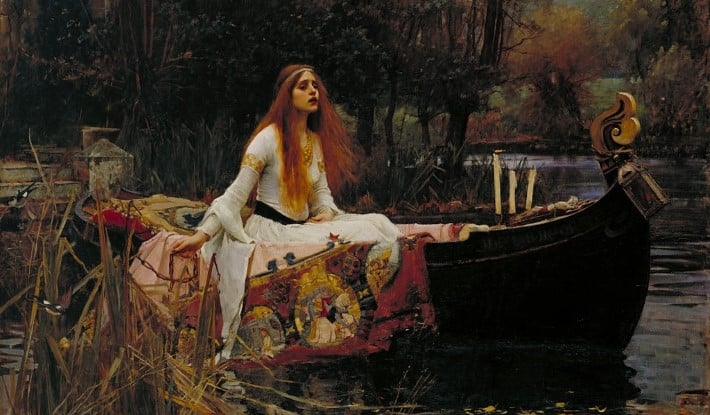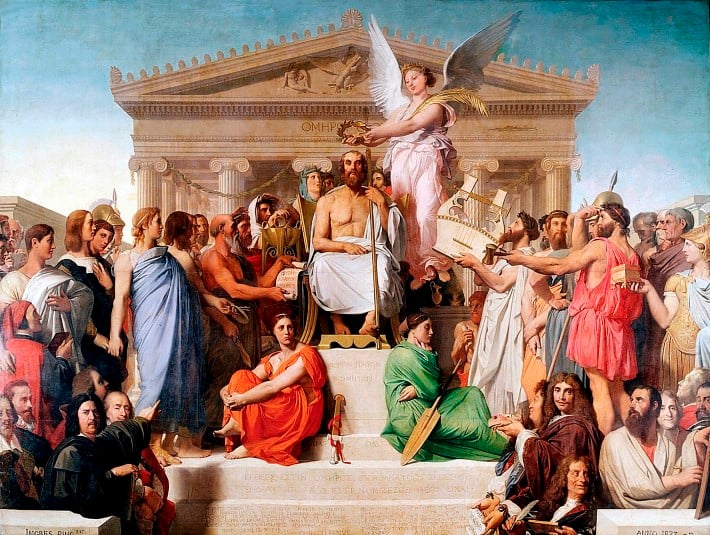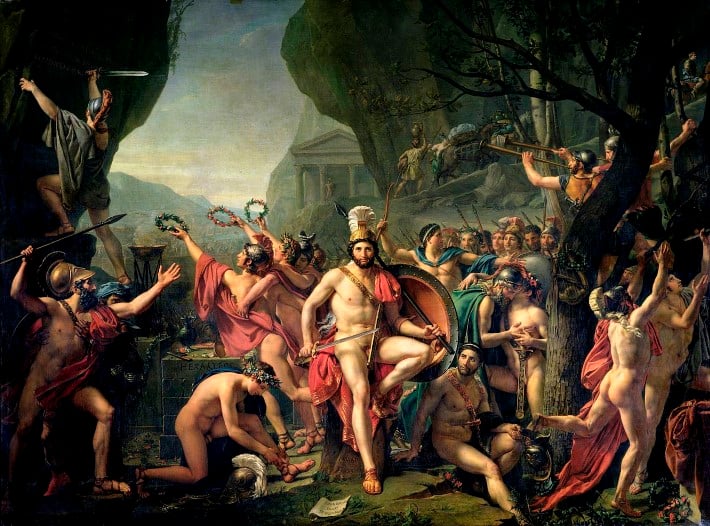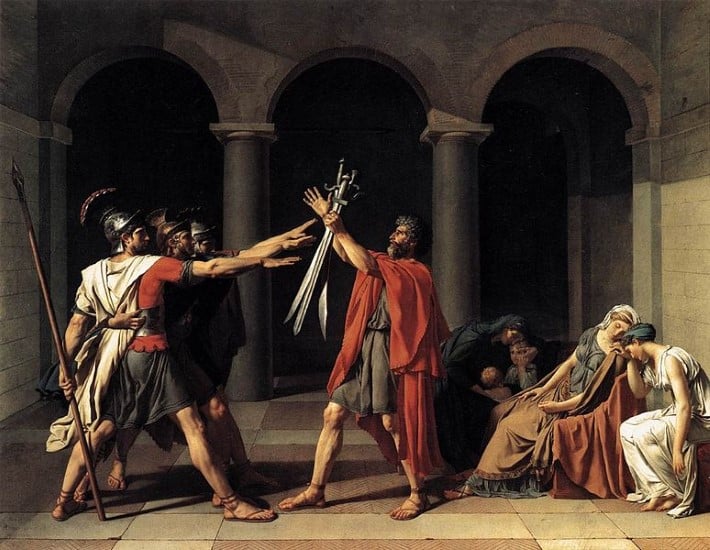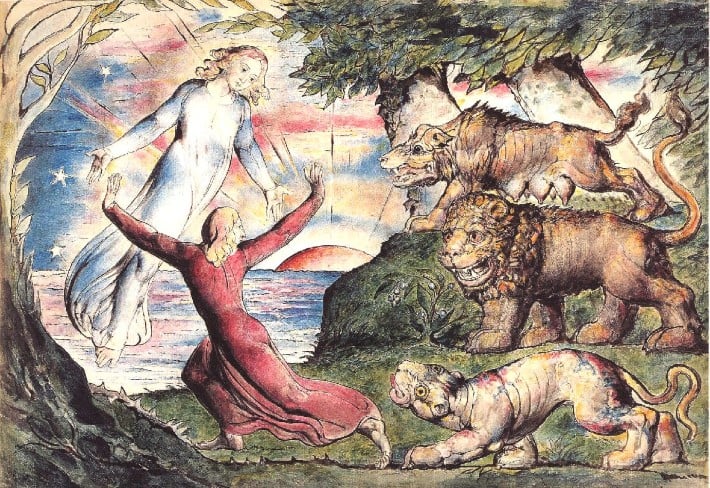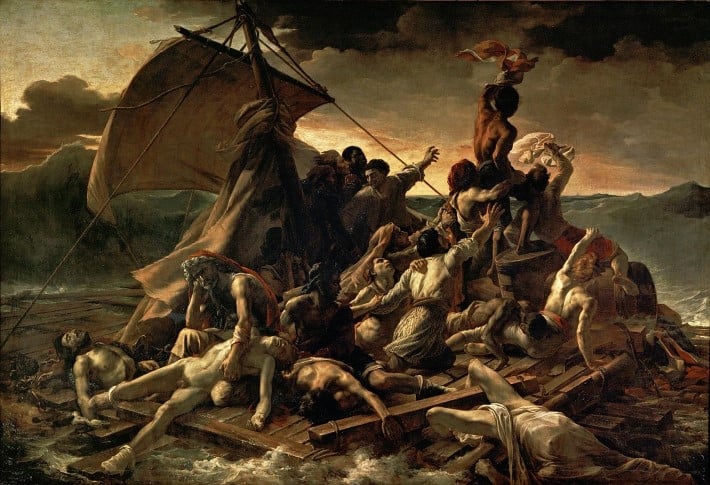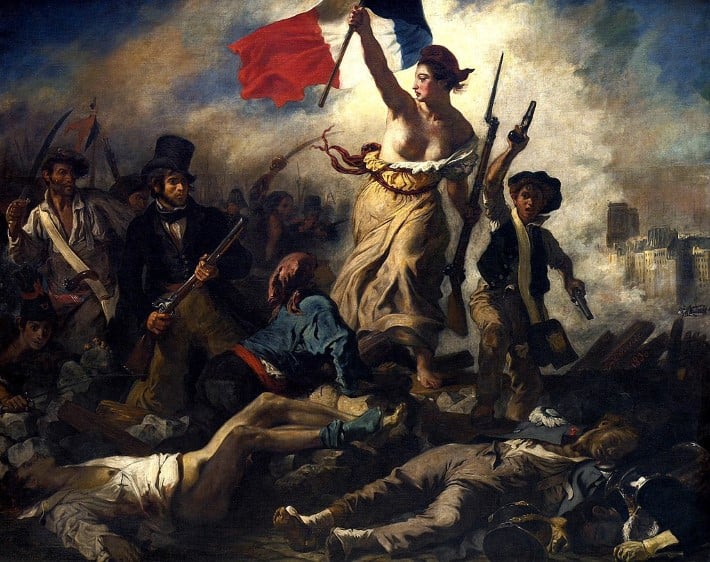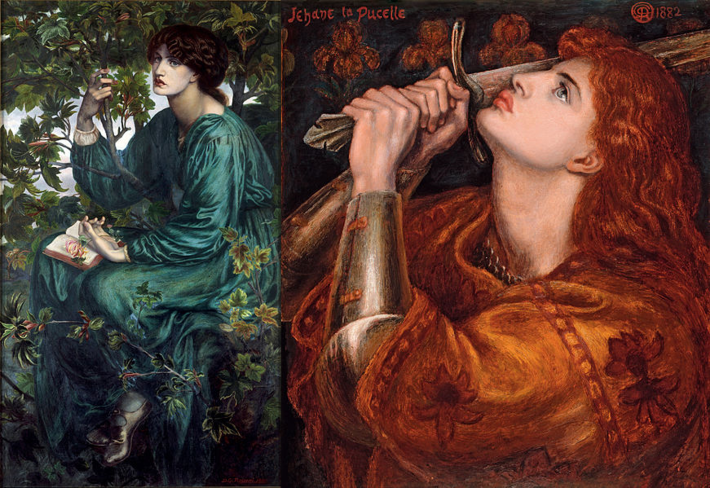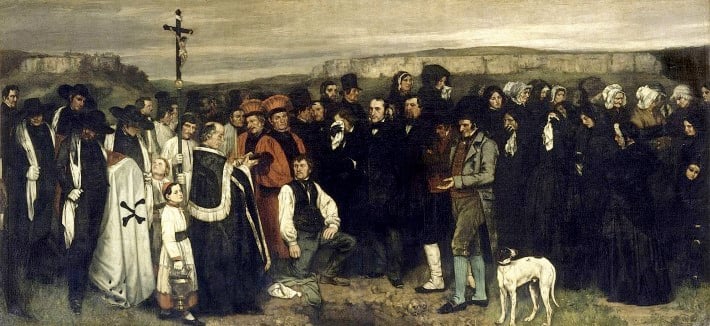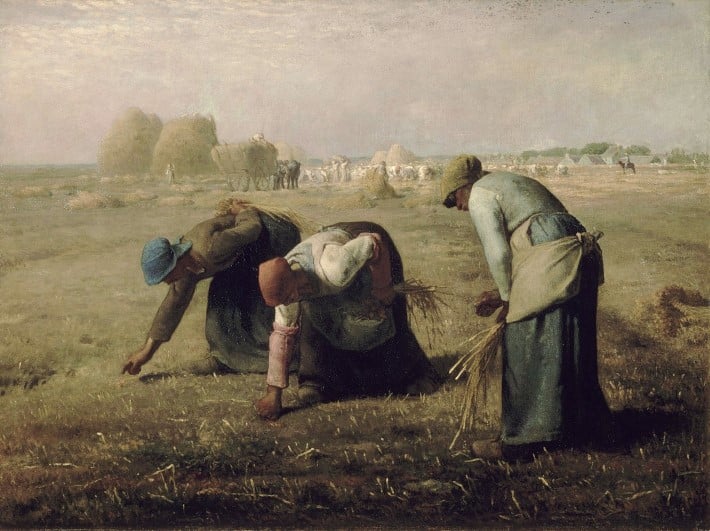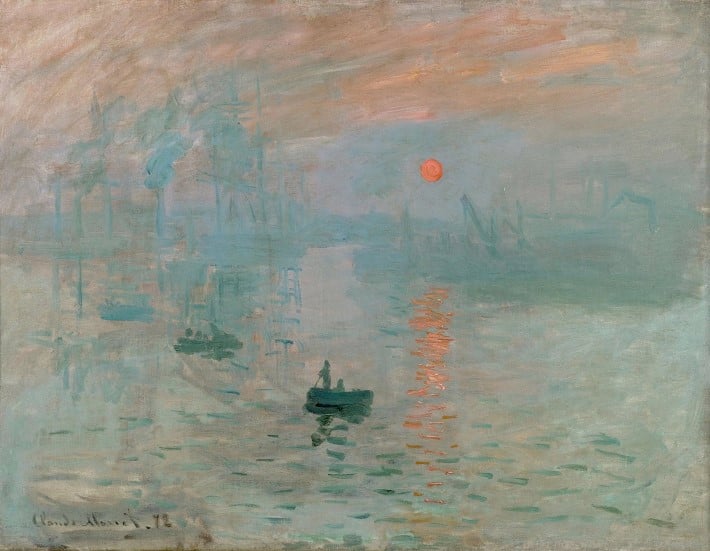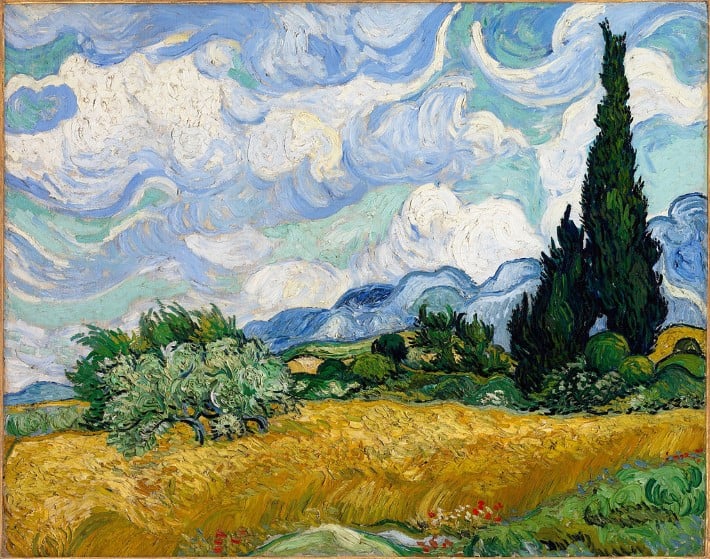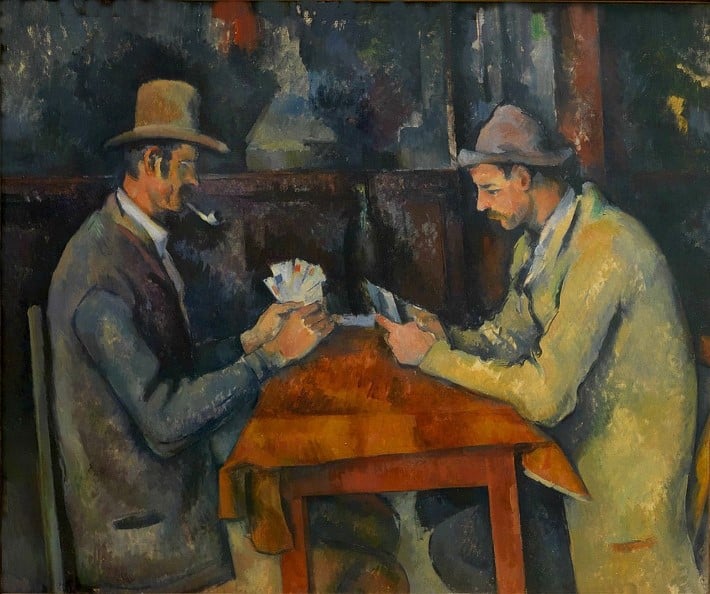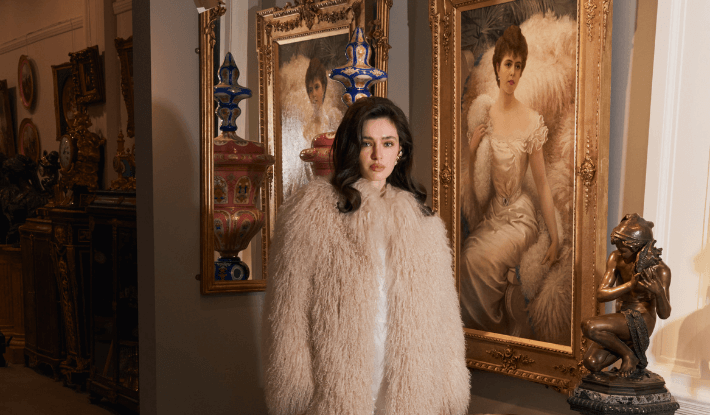The 19th Century was a period when Europe and the world experienced rapid and profound changes in all areas.
Politically and geographically Europe was constantly in a state of flux with revolutions in France, the breakdown of the Spanish, Holy Roman and French Napoleonic empires, and the growth of the British and German empires.
The period was also one of huge social change and urbanisation, which was instigated by the birth of science as a profession and two huge Industrial Revolutions, which defined the period as the age of the machine, impacting every level of society and improving just about every part of everyday life.
Art, and especially painting, in the 19th Century was no different. The changes over the course of 100 years were dramatic, transitioning from historic ‘Old Masters’ style works, to the dawn of Modernity.
Whereas previously artists were commissioned to produce works on behalf of a client or institution, it was during the 19th Century that artists really started to produce works of their own accord, exploring new and personal areas of interest.
New breakthroughs in transportation, especially rail travel, fuelled communication across borders and new ideas and artistic influences were able to spread quickly throughout Europe.
Thus, over the course of the 19th Century many innovative and original art movements and styles were born. Some were of these movements were short-lived and only flourished within small districts, whilst others were widespread and had a profound effect on the evolution of art. This blog explores just a few of the most important styles and movements of the period, showcasing how artistic freedoms transitioned from 1800 to 1900.
Neoclassicism: c. 1780-1900
In 1800, at the turn of the 19th Century, Neoclassicism was the dominant style of painting in Europe. The artistic movement had developed in the 18th Century as part of a larger decorative style that encompassed architecture, sculpture and the decorative arts.
Neoclassicism became popular after the discovery of the ancient sites of Herculaneum and Pompeii in Italy in the mid-18th Century.
The style took hold in the 1780’s in the run-up to the French Revolution and flourished under the Empire of Napoleon I in the early 19th Century
Neoclassical painting lasted until about the 1840’s, although many facets of Neoclassicism evolved into and influenced other styles throughout the century, notably at the end of the period with artists including Frederic Leighton (English, 1830-1896) and Sir Lawrence Alma-Tadema (Dutch, 1836-1912).
Characteristics of Neoclassical painting
Neoclassical paintings were derived from subjects of Classical antiquity or involved the painting of contemporary or newly invented compositions in a Classicized style.
Subjects were taken from, or inspired by the Epic – poems and stories from ancient Greece and Rome with a key example being the work of Homer, the Greek writer who penned the Iliad and Odyssey.
The Apotheosis of Homer by Jean-Auguste-Dominique Ingres, 1827. The painting shows the ancient writer Homer being crowned by a winged figure representing Victory. Other figures represented in the painting include Dante, Virgil, Raphael and Moliere. Louvre Museum, Paris. © Wikimedia Commons.
Typically, painters in the Neoclassical style attached a great deal of importance to the art of drawing, and so the surface of Neoclassical paintings were entirely smooth and utterly devoid of any brushstrokes.
Paintings were well-delineated – figures were easily distinguishable from shadow and were characteristically well-lit. Any shadows in paintings did not obscure or confuse any elements of the composition, and it the focal point of paintings were made very clear to the viewer.
This rational, proportionate approach to painting represented the French attitude toward the Revolution and the philosophies of the Enlightenment, or the Age of Reason, which called for serious, clear-headed paintings and subjects that celebrated the excellence of natural form.
Neoclassical painting is generally a form of history painting, a genre which traversed many styles but depended on historic subject matter. Ever since the 17th Century, history painting was seen as one of the most important genres in the well-established hierarchy of genres that artists had to conform to since the establishment of the Royal Academy in the 17th Century.
Leonidas at Thermompylae by Jacques-Louis David, 1814. © Wikimedia Commons.
The Royal Academy placed the greatest importance on history painting, which was backward looking and portrayed historic events in a way intended to inspire excellence in the present. Of second-most importance was portraiture, then genre painting, then landscapes. The most lowly painting was thought to be still life.
In many ways, Neoclassicism was similar to the Classical tradition, which had been popular since the Renaissance of the late 15th Century, except it was also politically and socially charged, representing metaphorical allegories that inspired the public and its leaders alike.
Neoclassical artists of the 19th Century
The most important of all Neoclassical painters is undoubtedly Jacques-Louis David (French, 1748-1825). David is credited with defining Neoclassical painting as we know it with the famous work the Oath of the Horatii, painted in 1784.
Oath of the Horatii by Jacques-Louis David, 1784. © Wikimedia Commons.
The Oath of the Horatii, a monumentally huge painting, was a success from the very moment it was first exhibited in the Paris Salon, for it symbolised and captured the French spirit in the years before the Revolution in a historic composition.
The painting depicts three brothers preparing to fight for their city, Rome, under the blessing of their father, and the heroic nationalism evident in the subject matter became huge propaganda for the French revolution.
David, a huge supporter of the Revolution, went on to become chief painter to Emperor Napoleon I, and produced a great deal of revolutionary propaganda in the form of Neoclassical paintings.
Jean-Auguste-Dominique Ingres (French, 1780-1867) was another important Neoclassical artist, who was famous for his portraiture as well as his history paintings, through which he sought to exemplify the very best of academic painting.
William-Adolphe Bouguereau (French, 1825-1905) was another artist that was greatly associated with Neoclassicism, and was a pivotal figure in landscape painting later in the 19th Century.
Romanticism: c. 1750-1890
Like Neoclassicism, Romanticism was part of a larger artistic movement that included literature and architecture as well as painting, originating in Britain in the mid-18th Century.
It wasn’t until around 1820 that the movement reached continental Europe, where it existed alongside Neoclassicism until the middle of the 19th Century, when both were finally eclipsed or developed into other styles.
However, unlike Neoclassicism, Romanticism rejected the order and idealisation that Neoclassicism promoted in favour of emphasising the emotional, personal and imaginative aspects of art.
The movement was partly a reaction against the Industrial Revolution, and in some part a reaction against the philosophically logical age of the Enlightenment. It instead favoured intense appreciation of natural beauty, the emotions and the senses over reason and logic.
Romanticism was also influenced by spiritual beliefs, folk culture and an interest in the medieval era, which characterised some of the painting produced during the period.
Characteristics of Romantic painting
Whilst the scope of Romantic painting in terms of subject matter was very broad, favouring emotional depictions, intensely sad and intensely heroic subjects. In terms of their aesthetic, Romantic paintings didn’t all look the same. In fact, they can look completely different from one another, because what mattered about this style was the feeling and the emotion – hence why it became known as Romanticism.
Paintings were defined by bold, linear drawing and strong juxtapositions of light and shade. Many Romantic paintings have a sketchy, grainy appearance with a certain softness to them, although this is not true of them all.
Dante running from the Three Beasts in William Blake’s Illustrations to Dante’s Divine Comedy: Hell, Canto 1, 1824. © Wikimedia Commons.
In England, where Romanticism had been established in the 18th Century, Romantic paintings depicted a range of subjects that included man’s relationship to God and his place in the cosmos, as well as history painting, but executed in the Romantic style. Landscape and seascape paintings were also very popular genres.
Later in France, Romanticism adapted and evolved to include the contemporary, and paintings glorified the terror, heroism or sadness of events. It is possible to see the influence of the Neoclassical on French Romantic painting, although the departure in style and motivation is clearly visible.
The Raft of the Medusa by Théodore Géricault, 1818-19. The emotion and drama is evident in theis painting, which depicts the survivors of the French ship the Medusa which ran aground in 1816. © Wikimedia Commons.
Romantic painters of the 19th Century
William Blake (English, 1757-1827), a painter and poet, is a seminal figure in Romantic painting, and is known for his distinctive illustrations and works in watercolour which created imaginary worlds inspired by gods and mystical powers, as well as famous writers including Dante and Shakespeare.
Theodore Gericault (French, 1791-1824) was another painter who had a huge impact on both Romanticism and the entire history of French painting. Unlike Blake, Gericault preferred to paint contemporary subjects focussing on the darker elements of human psychology.
Eugene Delacroix (French, 1798-1863) is often considered to be the leader of Romanticism in France. Like Gericault, he preferred contemporary subjects, of which he heightened the emotion and, naturally, the romance.
Liberty Leading the People by Eugene Delacroix, 1830. © Wikimedia Commons.
All Romantic painters shared an intense portrayal of emotion in their works that, despite their differences in subject matter, highlight the breadth of the Romantic movement in painting.
The Pre-Raphaelite Brotherhood: 1848-1854
The Pre-Raphaelites were a group of British artists – a brotherhood – that evolved from the Romantic movement in painting. The group controversially opposed the ‘ideal’ in art that was favoured by the Royal Academy as exemplified in the painting of the Renaissance master Raphael (Italian, 1483-1520).
The group who sought to revive British art by making it as creative, powerful and dynamic as late Medieval and early Renaissance painting prior to the work of Raphael, hence the term Pre-Raphaelite.
The Pre-Raphaelite Brotherhood was established in secret in 1848 by John Everett Millais (English, 1829-1896), William Holman Hunt (English, 1827-1910) and Dante Gabriel Rossetti (English, 1828-1882)
One of the greatest influences on the Pre-Raphaelites was John Ruskin (English, 1819-1900), an art critic, writer and social thinker who championed the connections between nature, art and society.
The Brotherhood went public in 1849 and grew in their number, yet by 1854 the group had dissipated.
Despite their short existence, the Pre-Raphaelite Brotherhood had a major impact on the history of art, with members establishing prominent places for themselves in the art world of the Victorian era, and their works highly revered.
Key characteristics of Pre-Raphaelite painting
The Pre-Raphaelites painted a variety of subjects, including religious works, subjects from poetry and literature, works inspired by spiritualism and nature, but ultimately they looked to serious themes, such as love and death, to express serious, genuine ideas. Heartfeltness was a key motivation in the Pre-Raphaelites work.
The importance of nature was paramount to the Pre-Raphaelite style, and to express and depict nature with reverence and care was considered of the utmost importance. This stemmed from the Pre-Raphaelite's opposition to the Industrial Revolution - they looked back to the calm and beauty of nature to offset the rapid, mechanical changes happening all around.
Ophelia by John Everett Millais, 1852. © Wikimedia Commons.
Pre-Raphaelite paintings revived the brilliant, bold colours of early Renaissance painting of the Quattrocento by developing a new technique of painting which involved painting thin glazes of pigment onto a wet white ground. This gave Pre-Raphaelite painting a distinctive luminous quality.
Pre-Raphaelite painting also focussed on extreme attention to detail and the absolute beauty of nature. They aimed to produce thoroughly good, wonderful pictures and statues.
One of the most distinctive characteristics is the portrayal of long-haired women with delicate features and long, sweeping dresses.
Left: The Day Dream by Dante Gabriel Rossetti, 1880. © Wikimedia Commons. Right: Joan of Arc by Dante Gabriel Rossetti, 1882. © Wikimedia Commons.
Realism: c. 1850-1900
Realism, often referred to as Naturalism, originated in France in the 1850’s in the wake of the 1848 French Revolution. There were equivalents of the style that developed in many other European countries and particularly in Russia, but Realism was most strongly associated with France and French painters.
The term ‘Realism’ does not mean the realistic appearance of works, as in to be opposite of abstraction. Up until this point nearly all artworks sought the ‘realistic’ portrayal of the composition. Rather, Realism was interested in the realism of the subject matter, marking a departure from Neoclassical history paintings and Romanticism, which elevated subjects to monumental importance. Realism was interested in common laborers and normal, everyday people as its subjects.
Revolting against the dominant Romantic style, Realism was concerned with the truthful representation of subjects that avoided artistic embellishments or implausible elements.
The style was popular until the late 19th Century, when it gradually became overtaken by Impressionism.
Key characteristics of Realism
Paintings in the Realist style depicted scenes of everyday life, seeking to appeal to the general public rather than just being aimed at the upper echelons of society.
Idealised, emotional and dramatic content was completely avoided in favour of matter-of-fact painted snapshots of interactions and scenes that did not shy away from the unpleasant aspects of life.
People of all walks of life, particularly those of the working class, were celebrated in Realism, in lifelike depictions within clear, logical compositions.
A Burial at Ornans by Gustave Courbet, 1849. © Wikimedia Commons.
Realist painters of the 19th Century
The most important and famous painter in the Realist style was Gustave Courbet (French, 1819-1877) who was entirely committed to painting exactly what he could see.
Courbet believed that the only possible source for art was the experience of the artist, and amongst his oeuvre he painted figurative compositions, landscapes and still life paintings.
Jean-Francois Millet (French, 1814-1875) is another famous painter who worked in the Realist style and is widely celebrated for his scenes of peasant farmers, as shown in the painting ‘The Gleaners’ below.
The Gleaners by Jean-Francois Millet, 1857. © Wikimedia Commons.
Other Realist artists included Jean-Baptiste-Camille Corot (French, 1796-1875), who was known for his paintings of interior scenes, particularly people reading, as well as his landscapes, and Honoré Daumier (French, 1808-1879), whose Realist works were highly politicised and included depictions of politicians amongst other works depicting interior scenes.
Impressionism: c. 1870-1920
Impressionism was a stylistic movement of painting that emerged in the 1870’s in France and became popular throughout Europe for the next fifty years.
The movement originated with a group of radical Parisian painters who gained fame during the period for their violation of the rigorous rules of academic painting, which favoured carefully finished, realistically precise paintings at the time.
These artists were initially heavily criticised and could not exhibit at the prestigious Paris Salon, and so went about founding the Société Anonyme Coopérative des Artistes Peintres, Sculpteurs, Graveurs, (the Cooperative and Anonymous Association of Painters, Sculptors, and Engravers), where they could exhibit independently.
The forerunners of the Impressionist movement shared interests in painting ‘from life’, outside in the countryside, favouring landscape scenes and social situations over grand, overly dramatic scenes.
However, unlike Realism, which placed all importance on representational honesty and a photograph-like appearance, Impressionism was not just a movement, but it introduced a whole new visual and technical styles for painting.
Key features of Impressionist paintings
Impressionism comes from the word ‘impressionist’, which was used pejoratively in response to an exhibition in which the works, which we now know as Impressionism, were shown. The term was meant to mean that the works were not solid and meaningful, they were merely an impression.
The key features of Impressionism are the fine, light, highly visible brushstrokes that wash across the paintings and the importance of the attention to the accurate depiction of the light throughout the day or night.
The Bridge at Argenteuil by Claude Monet, 1874. In this painting it is clear to see the small, visible brushstrokes that make up Impressionist paintings, as well as the contrast of the yellows and blues in the water which makes use of colour theory to contrast against one another strongly. © Wikimedia Commons.
The Impressionist movement coincided with significant advances made in paint technology – premixed paints in new, vibrant colours became available in tubes, which allowed artists to work more spontaneously and very easily outside and so in some Impressionist paintings there are even grains of sand or blades of grass that became stuck to the canvas whilst the artist was working out of doors.
The Impressionists also made use of new developments in colour theory that were published by Michel Eugene Chevreul in the mid-19th Century on the perfect harmony of contrasting colours. These contrasting colours make one another more vivid when used together.
Impressionist painters of the 19th Century
Impression, sunrise by Claude Monet, 1872. © Wikimedia Commons.
The most widely celebrated was Claude Monet (French, 1840-1926), and it was after his work ‘Impression, sunrise’, painted in 1872, that the entire movement was named.
Monet is famous for his landscape scenes and his paintings of gardens, particularly waterlilies, in vibrant, pastel shades.
Another important Impressionist artist, who bridged the gap between Realism and Impressionism, is Édouard Manet (French, 1832-1883). Manet painted several highly controversial works which make subtle use of Impressionistic techniques and yet capture the essence of the movement.
Déjeuner sur l'herbe by Édouard Manet, 1863. This painting was initially highly criticised, because the nude woman was seen at the time to be distasteful. © Wikimedia Commons.
Post-Impressionism
Post-Impressionism was the last important European artistic movement of the 19th century, which took place predominantly in France between the years 1886-1905.
The movement was born out of many artists’ dissatisfaction with the blurred, blended appearance of Impressionist subjects and compositions, which they thought lacked structure. The Post-Impressionists sought to restore order and structure to paintings, to make solid, durable art that celebrated a distinct, artistic style.
What were the characteristics of Post-Impressionist painting
Post-Impressionist painting was not unified by one overarching style, and was instead made up of a wide range of techniques and styles that were associated with the artists that developed them.
However, most Post-Impressionist paintings were unified by their emotive qualities and rich symbolism. Thick, painterly brushstrokes characterised many Post-Impressionist paintings, and were arranged in orderly, directional patterns to make up a composition.
The colours used were bold and vivid, bordering on unnaturally vibrant, and subject matter ranged from landscape painting to still life painting, encompassing genre scenes and social compositions as well.
Who were some of the most famous Post-Impressionist painters
Some of the most famous artists of all time worked during the Post-Impressionist period.
Wheat Field with Cypresses by Vincent Van Gogh, 1889. © Wikimedia Commons.
Vincent van Gogh (Dutch, 1853-1890) characterised the period with his impulsive, tangibly expressive brushstrokes, bold colours and tragically and highly emotive works, which ranged from his self-portraits to still life paintings to landscape scenes.
Van Gogh is most ardently remembered as the romantic ideal of the tortured artist, battling with mental health problems which lead to his eventual suicide. Despite his obvious genius, he lived in poverty and it was only posthumously that he gained widespread acclaim.
Paul Cézanne (French, 1839-1906) was another leading Post-Impressionist painter who has also been credited with laying the foundations for the fresh, new, radically different art of the 20th Century.
Cézanne is famous for his intense planes of colour and small brushstrokes, which create highly distinctive works in the artist's unique, personal style.
The Card Players by Paul Cézanne, 1892-95. © Wikimedia Commons.
Other very important Post-Impressionist artists included Paul Gauguin (French, 1848-1903), who was known for his intuitive use of colour, and Henri Rousseau (French, 1844-1910), a self-taught genius with a strong sense of his own artistic style.
What is the legacy of 19th Century painting?
The legacy of 19th Century painting is immense. The huge changes toward artistic freedom that occurred in the final decades of the century without doubt paved the foundations for the contemporary art world - and indeed the art market - that we enjoy today.
Paintings of the 19th Century, in all their diverse styles, are some of the most collectible artworks ever made, with names like Van Gogh and Monet reaching unthinkable sums in auction. Some works, which make up the highlights of the very best and biggest museums, can only be described as absolutely priceless.
It is thanks to our reverence for these antique paintings that so many of them have been so well preserved, and that we can continue enjoying them today.




